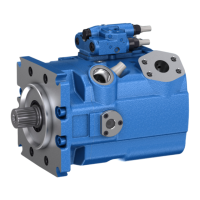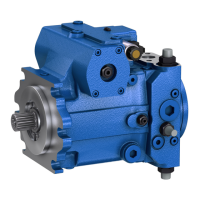52/68 Commissioning
Bosch Rexroth AG, A20V(L)O Series 1, RE 93100-01-B/2019-09-10
8.2 Running-in phase
NOTICE
Property damage due toinsufficient viscosity!
Elevated hydraulic fluid temperature may excessively reduce viscosity and damage
theproduct!
▶ Monitor theoperating temperature during therunning-in phase,
e.g.bymeasuring theleakage temperature.
▶ Reduce theloading (pressure, rotational speed) oftheaxial piston unit
ifunacceptable operating temperatures and/or viscosities occur.
▶ Excessively high operating temperatures indicate faults that have tobe analyzed
and eliminated.
The bearings and sliding surfaces are subject toarunning-in phase. The increased
friction atthestart oftherunning-in phase results inincreased heat development
which decreases over time. Volumetric and mechanical-hydraulic efficiency isalso
greater until therunning-in phase ofabout 10operating hours isconcluded.
To ensure that contamination inthe hydraulic system does not damage theaxial
piston unit, BoschRexroth recommends thefollowing procedure after therunning-in
phase:
▶ After therunning-in phase, have ahydraulic fluid sample analyzed for therequired
cleanliness level.
▶ Change thehydraulic fluid iftherequired cleanliness level isnot
reached. Ifalaboratory test isnot carried out after therunning-in phase,
itisrecommended tochange thehydraulic fluid.
8.3 Recommissioning after standstill
Depending onthe installation conditions and ambient conditions, changes may occur
inthe hydraulic system which make recommissioning necessary.
The following criteria may make recommissioning necessary:
• Air and/or water inthe hydraulic system
• Old hydraulic fluid
• Other contamination
▶ Before recommissioning, proceed asdescribed inchapter8.1 "Initial
commissioning" onpage49.

